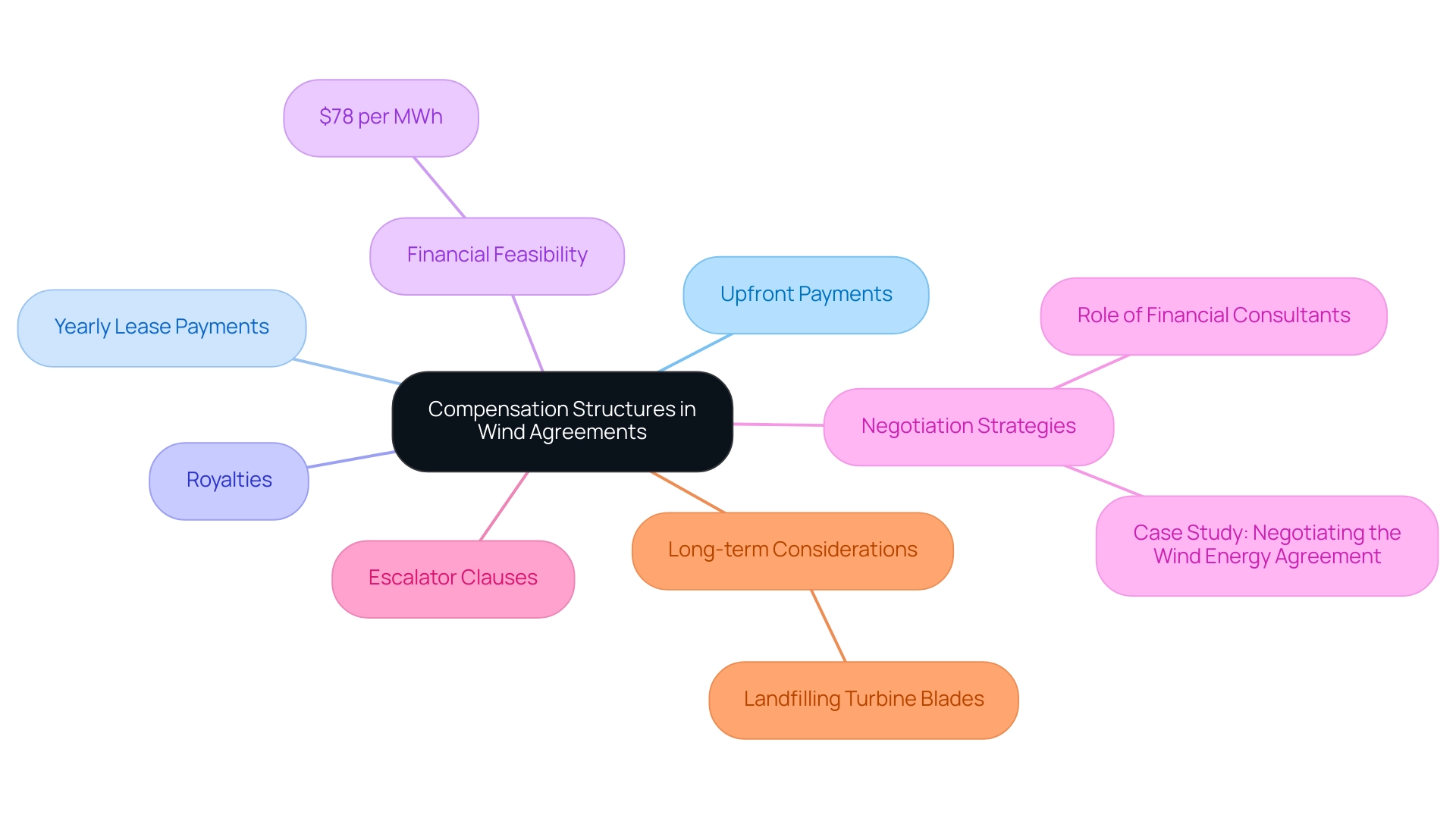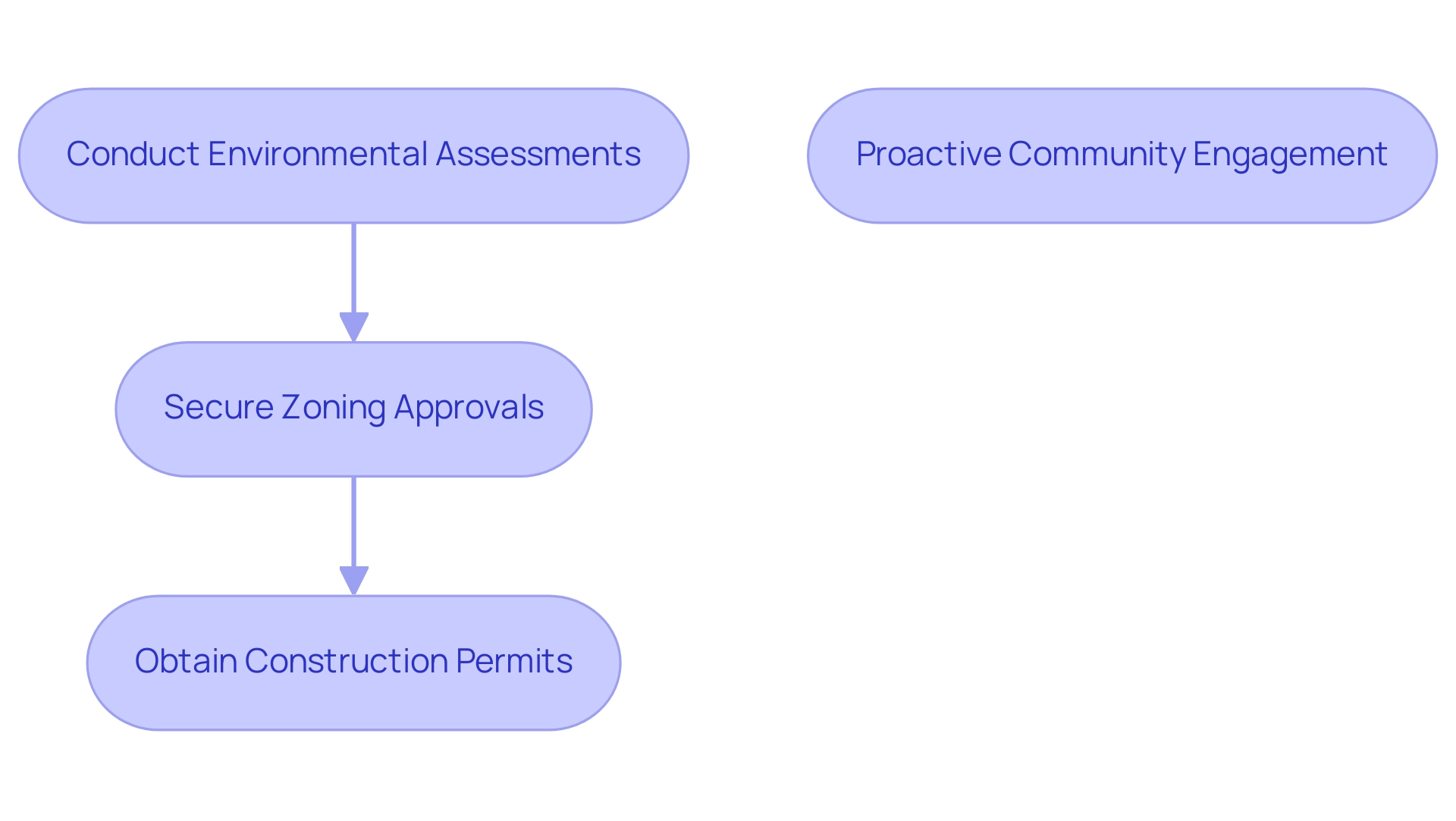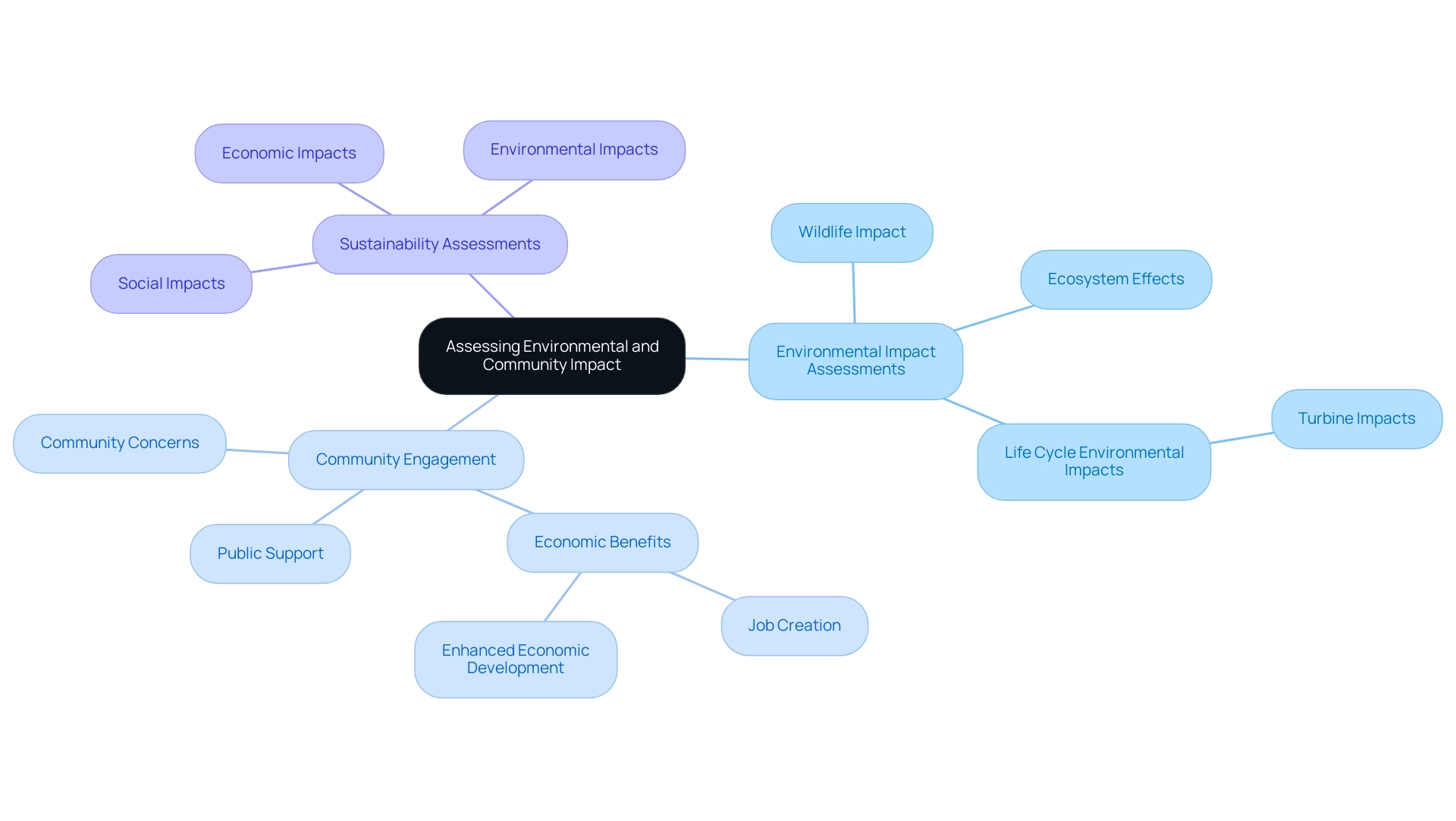Introduction
Navigating the complexities of wind energy development requires a comprehensive understanding of various legal and financial frameworks that impact landowners. As the demand for renewable energy sources escalates, property owners must familiarize themselves with:
- Wind rights
- Title coverage
- The intricacies of agreements such as leases and easements
With evolving regulations and compensation structures, the landscape of wind energy is continually changing, presenting both opportunities and challenges. This article delves into the essential elements of wind energy agreements, the permitting process, community impacts, and effective negotiation strategies, equipping landowners with the knowledge needed to make informed decisions in this burgeoning sector.
Understanding Wind Rights and Title Coverage
Air usage involves the legal privileges that property owners have concerning the use of airflow on their land. These entitlements can be complex, influenced by state-specific laws and regulations that oversee power generation. The landscape is changing; for example, proposed legislation in Wisconsin seeks to enable local governments to implement more stringent regulations on energy systems under specific circumstances.
This could significantly affect property owners by restricting the range of renewable power development, making it essential for them to comprehend how such regulations interact with title insurance, which safeguards against disputes over these rights. Additionally, in 2021, Kansas legislators considered statewide setbacks for turbines (SB 279), proposing distances based on turbine height, although the bill did not advance out of committee. This emphasizes persistent regulatory difficulties in the energy sector that property owners must manage.
Title coverage plays a vital role, as it protects landowners from potential disputes over these entitlements. Obtaining title insurance that specifically covers aerial rights is crucial for reducing risks linked to claims from third parties or previous owners. Recent data indicates that energy projects delivered over $2 billion in state and local tax payments and land-lease payments last year, underscoring the financial significance of these rights.
Moreover, a prevalent misconception is that turbines use more power in their manufacturing than they produce. In reality, a typical turbine repays its carbon footprint in less than six months, providing emission-free electricity for 20 to 30 years, making them a sustainable power source. By thoroughly understanding air rights and the nuances of title insurance, property owners are better equipped to navigate the complexities of renewable projects and utilize wind energy land title services to engage effectively with developers.
As noted by the Center for Sustainable Systems at the University of Michigan, wind power represents a crucial step towards sustainable power generation, highlighting the importance of solid legal foundations for its development.
Navigating Wind Energy Agreements: Leases vs. Easements
In the context of renewable projects, property owners must navigate the distinctions between two principal agreement types, which are essential for wind energy land title services: leases and easements. A lease usually provides a developer the ability to use the land for a specified duration, frequently outlining rent and royalties that depend on power generation. This arrangement can be financially advantageous, as it enables property owners to generate income based on the output of the wind energy land title services produced by the wind.
On the other hand, an easement allows particular uses of the land without transferring ownership rights, enabling the installation of structures such as turbines or power lines while preserving the property owner's control over the site. Each agreement carries distinct implications regarding land use, compensation, and duration. For instance, leases often provide higher average compensation rates compared to easements, which may restrict the property owner's opportunities for additional uses of their land.
Furthermore, with the new phrase 'solar or atmospheric resource development' being acknowledged, property holders must be aware of how public land use can influence their agreements. It is also important to note that lease assignments can be applied for, and approved assignments will not change lease terms, ensuring stability for property owners. Additionally, holders of solar or renewable resource development grants should remember to submit renewal applications at least 120 days prior to expiration, highlighting the importance of prompt actions in managing their agreements.
Grasping these distinctions is essential for landowners to safeguard their property rights and maximize their financial gains from renewable projects by utilizing wind energy land title services in a swiftly changing market.
Evaluating Compensation Structures in Wind Agreements
Compensation frameworks in renewable agreements can differ greatly, including:
- Upfront payments
- Yearly lease payments
- Royalties linked to power generation
In 2022, the cost of levelized power for large distributed turbine systems was reported at $78 per megawatt-hour (MWh), as noted by the National Renewable Resources Laboratory, indicating the financial feasibility of such projects. Landowners are encouraged to conduct a thorough evaluation of these compensation models related to wind energy land title services, weighing both immediate financial benefits and long-term income potential.
Collaborating with financial consultants who focus on renewable projects is essential for comprehending the complete range of possible profits from turbine power. These professionals can assist in negotiating terms that accurately reflect the value of the land and the profitability of the project. The intricacies associated with negotiating agreements for renewable resources are emphasized in a case study named 'Negotiating the Renewable Resource Agreement,' which examines the significance of meticulous negotiation to safeguard property owners' rights and guarantee equitable compensation.
Furthermore, property owners should pay close attention to any escalator clauses within agreements, as these can significantly influence compensation over time. Furthermore, taking into account the low cost of landfilling turbine blades can offer insights into the long-term consequences of renewable projects. By strategically navigating these aspects, landowners can secure more favorable terms and ensure their rights and interests are adequately safeguarded in the changing environment of renewable power.

Understanding the Permitting Process for Wind Projects
The permitting procedure for renewable power projects is complex and usually necessitates several authorizations from local, state, and occasionally federal agencies. Essential steps include:
- Conducting thorough environmental assessments
- Securing zoning approvals
- Obtaining construction permits
As of 2023, there are approximately 92,000 turbines installed across distributed energy applications nationwide, illustrating the extensive engagement in this sector.
The White House has established greenhouse gas pollution reduction objectives and revealed measures to enhance the electric grid, highlighting the essential role of renewable sources in achieving these goals. Moreover, a standard turbine offsets its carbon footprint in under six months and produces emission-free electricity for 20 to 30 years, highlighting the ecological advantages of such projects. Landowners are encouraged to collaborate closely with developers and utilize wind energy land title services to navigate the necessary permits, ensuring that all applications are submitted accurately to prevent delays.
According to Linsie Zou, a former research intern at The Hamilton Project,
Community opposition can be expressed in the form of lawsuits, since government-issued permits are open to challenge in court.
Thus, proactive engagement with local government and community stakeholders is crucial early in the process. This approach not only facilitates smoother permitting but also addresses potential concerns before they escalate, paving the way for successful project implementation.
Furthermore, the case study titled 'Twelve Economic Facts on Energy and Climate Change' emphasizes the significance of adopting efficient solutions to reduce climate damages from resource use, reinforcing the economic implications of effective permitting processes.

Assessing Environmental and Community Impact
Before entering into contracts for renewable projects, landowners must prioritize thorough environmental impact assessments. These evaluations are instrumental in identifying potential repercussions on wildlife, land use, and local ecosystems. As environmental scientist Fatos Germirli Babuna emphasizes, understanding the life cycle environmental impacts of turbines is crucial for achieving sustainable development, especially considering the challenges that may arise.
This comprehension corresponds with the worldwide drive for renewable sources, exemplified by the Government of India's ambitious goal of 175 GW of renewable power by 2022, underscoring the urgency and scope of such initiatives. Interacting with the local community to evaluate feelings about renewable initiatives is equally vital. By addressing community concerns and effectively communicating the benefits of such projects—like job creation and enhanced economic development—landowners can foster public support and mitigate opposition.
Recent approaches in community involvement have shown that active participation can result in more positive results for renewable resource projects. Furthermore, the case study titled "Sustainability Assessment Recommendations" underscores the importance of conducting thorough sustainability assessments that consider environmental, economic, and social impacts, thus ensuring that projects align with both environmental sustainability and community interests.

Preparing for Negotiations with Developers
Effective preparation is crucial for property owners entering negotiations with developers of [[[[[[[[[[[[[[[[[[[[wind [energy land title services](https://harbingerland.com)](https://blog.harbingerland.com/how-to-navigate-wind-energy-land-acquisition-a-step-by-step-guide)](https://blog.harbingerland.com/how-to-navigate-wind-energy-land-acquisition-consulting-a-step-by-step-guide)](https://blog.harbingerland.com/how-to-conduct-effective-wind-energy-title-research-a-step-by-step-guide)](https://blog.harbingerland.com/how-to-conduct-effective-wind-energy-title-research-a-step-by-step-guide)](https://blog.harbingerland.com/how-to-conduct-effective-wind-energy-title-research-a-step-by-step-guide)](https://blog.harbingerland.com/understanding-wind-energy-land-services-a-comprehensive-tutorial-for-project-developers)](https://blog.harbingerland.com/understanding-wind-energy-land-services-a-comprehensive-tutorial-for-project-developers)](https://mcafeetaft.com/wind-law-and-negotiations-from-a-landowners-perspective)](https://blog.harbingerland.com/understanding-wind-energy-land-services-a-comprehensive-tutorial-for-project-developers)](https://blog.harbingerland.com/understanding-wind-energy-land-services-a-comprehensive-tutorial-for-project-developers)](https://blog.harbingerland.com/understanding-wind-energy-land-services-a-comprehensive-tutorial-for-project-developers)](https://blog.harbingerland.com/how-to-navigate-wind-energy-land-acquisition-consulting-a-step-by-step-guide)](https://blog.harbingerland.com/how-to-navigate-wind-energy-land-acquisition-consulting-a-step-by-step-guide)](https://blog.harbingerland.com/how-to-navigate-wind-energy-land-acquisition-consulting-a-step-by-step-guide)](https://blog.harbingerland.com/understanding-wind-energy-land-services-a-comprehensive-tutorial-for-project-developers)](https://mcafeetaft.com/wind-law-and-negotiations-from-a-landowners-perspective). Collecting comprehensive information about the property, such as its current market value, existing legal entitlements, and any prior agreements, is essential for informed discussions on wind energy land title services. Notably, renewable projects typically have an operational period lasting 20-30 years, highlighting the long-term implications of these negotiations.
Engaging with legal and financial advisors is essential to thoroughly grasp the implications of the proposed terms regarding wind energy land title services. As one legal advisor notes, 'Understanding the nuances of the agreements can significantly impact the financial outcomes for property owners.' Prioritizing specific interests, whether they revolve around financial compensation, land use rights, or considerations for the local community, empowers property owners to negotiate from a position of strength with respect to wind energy land title services.
For instance, a recent case study demonstrated a data-driven approach for forecasting hedge costs, which helped landowners achieve more favorable terms in their negotiations. This preparation not only bolsters their confidence but also ensures that their interests are articulated clearly and effectively throughout the negotiation process.
Conclusion
Understanding the intricacies of wind energy development is essential for landowners who wish to navigate this evolving landscape effectively. Key points discussed include:
- The importance of grasping wind rights and title coverage, which serve as the foundation for any agreements involving wind energy projects.
- Awareness of state-specific laws and regulations, as these can significantly impact the potential for development and the associated financial benefits.
Furthermore, distinguishing between leases and easements is vital for landowners to optimize their financial outcomes. Each agreement type carries different implications for land use and compensation, and understanding these can empower landowners to negotiate more favorable terms. Evaluating compensation structures and engaging with financial advisors can also enhance the potential for long-term income from wind energy projects.
The permitting process and thorough environmental assessments are critical components that landowners must navigate to ensure compliance with regulations and to address community concerns. Proactive engagement with local stakeholders can facilitate smoother project implementation, ultimately leading to more successful outcomes.
In preparation for negotiations with developers, gathering comprehensive information and seeking guidance from legal and financial advisors will enable landowners to advocate for their interests effectively. By prioritizing specific goals and understanding the nuances of agreements, landowners can secure their rights and maximize the benefits derived from wind energy development.
As the demand for renewable energy continues to grow, being informed and prepared is essential for landowners looking to participate in this promising sector. Embracing the opportunities while being mindful of the challenges will ensure that landowners can contribute to a sustainable energy future while also protecting their interests.
Frequently Asked Questions
What is air usage in relation to property ownership?
Air usage refers to the legal privileges that property owners have concerning the use of airflow on their land, which can be influenced by state-specific laws and regulations related to power generation.
How might proposed legislation in Wisconsin affect property owners?
Proposed legislation in Wisconsin aims to allow local governments to impose stricter regulations on energy systems, which could limit renewable power development options for property owners.
What is the significance of title insurance for property owners?
Title insurance is crucial as it protects landowners from disputes over air rights and entitlements, helping to mitigate risks associated with claims from third parties or previous owners.
What recent legislative activity in Kansas relates to wind energy?
In 2021, Kansas legislators considered a bill (SB 279) proposing statewide setbacks for turbines based on their height, although the bill did not advance out of committee, highlighting ongoing regulatory challenges in the energy sector.
How do wind turbines impact the environment?
A common misconception is that turbines consume more energy in their manufacturing than they produce. In fact, a typical turbine repays its carbon footprint in less than six months and generates emission-free electricity for 20 to 30 years.
What types of agreements are important for property owners in renewable projects?
The two principal agreement types are leases and easements. Leases allow developers to use the land for a specified duration and often include rent and royalties based on power generation, while easements permit specific land uses without transferring ownership rights.
What are the financial implications of leases versus easements?
Leases typically offer higher compensation rates compared to easements, which may limit the property owner's ability to use their land for other purposes.
What should property owners know about solar or atmospheric resource development?
Property owners should be aware of how public land use can affect their agreements, especially with the recognition of solar or atmospheric resource development in legal contexts.
What is the process for lease assignments and renewals?
Lease assignments can be applied for without changing the original lease terms, ensuring stability for property owners. Additionally, holders of renewable resource development grants must submit renewal applications at least 120 days before expiration.
Why is understanding these agreements important for property owners?
Grasping the distinctions between leases and easements is essential for property owners to protect their rights and maximize financial benefits from renewable projects in a rapidly evolving market.
List of Sources
- Understanding Wind Rights and Title Coverage
- Wind Power Facts and Statistics | ACP (https://cleanpower.org/facts/wind-power)
- Wind, Solar and Siting: A Look at Recent Laws and Legislative Trends in the Midwest - CSG Midwest (https://csgmidwest.org/2024/02/29/wind-solar-and-siting)
- Wind Energy Factsheet (https://css.umich.edu/publications/factsheets/energy/wind-energy-factsheet)
- Navigating Wind Energy Agreements: Leases vs. Easements
- Rights-of-Way, Leasing, and Operations for Renewable Energy (https://federalregister.gov/documents/2024/05/01/2024-08099/rights-of-way-leasing-and-operations-for-renewable-energy)
- Evaluating Compensation Structures in Wind Agreements
- WINDExchange: Economics and Incentives for Wind (https://windexchange.energy.gov/projects/economics)
- Wind Energy Factsheet (https://css.umich.edu/publications/factsheets/energy/wind-energy-factsheet)
- mcafeetaft.com (https://mcafeetaft.com/wind-law-and-negotiations-from-a-landowners-perspective)
- Electricity – Renewables 2024 – Analysis - IEA (https://iea.org/reports/renewables-2024/electricity)
- Understanding the Permitting Process for Wind Projects
- Wind Market Reports: 2024 Edition (https://energy.gov/eere/wind/wind-market-reports-2024-edition)
- Eight facts about permitting and the clean energy transition - The Hamilton Project (https://hamiltonproject.org/publication/economic-fact/eight-facts-permitting-clean-energy-transition)
- brookings.edu (https://brookings.edu/articles/eight-facts-about-permitting-and-the-clean-energy-transition)
- Wind Power Facts and Statistics | ACP (https://cleanpower.org/facts/wind-power)
- Assessing Environmental and Community Impact
- mdpi.com (https://mdpi.com/2071-1050/16/13/5365)
- Selected Environmental Impact Indicators Assessment of Wind Energy in India Using a Life Cycle Assessment (https://mdpi.com/1996-1073/15/11/3944)
- Preparing for Negotiations with Developers
- Wind – Renewables 2020 – Analysis - IEA (https://iea.org/reports/renewables-2020/wind)
- gislason.com (https://gislason.com/negotiating-wind-and-solar-agreements)
- Pricing and hedging wind power prediction risk with binary option contracts (https://sciencedirect.com/science/article/pii/S0140988323004589)




